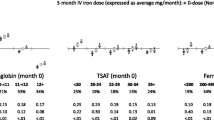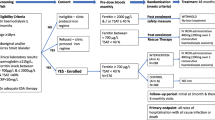Abstract
Background
Anaemia among haemodialysis patients is treated with iron and erythropoietin-stimulating agents (ESAs). ESAs reduce requirements for blood transfusions but are also expensive and overzealous use may be associated with adverse outcomes. Recent international trends have been characterised by reduced ESA doses and a greater reliance on intravenous (IV) iron. We determined trends in prescribing patterns of ESAs and IV iron for the treatment of anaemia in two representative Irish dialysis centres and correlated with current guidelines and international trends.
Methods
Patient data was accessed from the Kidney Disease Clinical Patient Management System (KDCPMS) for the period 2012 to 2014. We generated reports on ESA and iron doses, lab data (haemoglobin (Hb), transferrin saturation (TSAT) and ferritin) and patient population characteristics. We mapped the trends in ESA, iron dosing and lab parameters achieved. A linear mixed model determined the significance of these trends over time.
Results
ESA dosing became lower in the second, third and fourth quarters of 2014. Dosing of iron increased throughout but a large increase was seen in the third and fourth quarters of 2014. Ferritin levels decreased and TSAT and haemoglobin levels increased. Changes in iron dosing were significant with p value of < 0.05.
Conclusions
Our findings are consistent with recent global trends toward increasing iron use. Such trends may have economic implications given the high cost of ESAs and the relative affordability of iron. In addition, the potential harm of excessive iron dosing may need to be considered.






Similar content being viewed by others
References
Revicki DA, Brown RE, Feeny DH, Henry D, Teehan BP, Rudnick MR, Benz RL (1995) Health-related quality of life associated with recombinant human erythropoietin therapy for predialysis chronic renal disease patients. Am J Kidney Dis 25(4):548–554
Besarab A, Bolton WK, Browne JK, Egrie JC, Nissenson AR, Okamoto DM, Schwab SJ, Goodkin DA (1998) The effects of normal as compared with low hematocrit values in patients with cardiac disease who are receiving hemodialysis and epoetin. N Engl J Med 339(9):584–590
Drüeke TB, Locatelli F, Clyne N, Eckardt KU, Macdougall IC, Tsakiris D, Burger HU, Scherhag A, CREATE Investigators (2006) Normalization of hemoglobin level in patients with chronic kidney disease and anemia. N Engl J Med 355(20):2071–2084
Singh AK, Szczech L, Tang KL, Barnhart H, Sapp S, Wolfson M, Reddan D, CHOIR Investigators (2006) Correction of anemia with epoetin alfa in chronic kidney disease. N Engl J Med 355(20):2085–2098
Pfeffer MA, Burdmann EA, Chen C-Y, Cooper ME, de Zeeuw D, Eckardt KU, Feyzi JM, Ivanovich P, Kewalramani R, Levey AS, Lewis EF, McGill J, McMurray J, Parfrey P, Parving HH, Remuzzi G, Singh AK, Solomon SD, Toto R, TREAT Investigators (2009) A trial of darbepoetin alfa in type 2 diabetes and chronic kidney disease. N Engl J Med 361(21):2019–2032
Del Vecchio L, Locatelli F (2014) New treatment approaches in chronic kidney disease-associated anaemia. Expert Opin Biol Ther 14(5):687–696
McMurray JJV, Parfrey PS, Adamson JW et al (2012) Kidney Disease: Improving Global Outcomes (KDIGO) anemia work group. KDIGO clinical practice guideline for anemia in chronic kidney disease. Kidney Int Suppl 2(4):279–335
Madore F, White CT, Foley RN, Barrett BJ, Moist LM, Klarenbach SW, Culleton BF, Tonelli M, Manns BJ (2008) Clinical practice guidelines for assessment and management of iron deficiency. Kidney Int 74:S7–S11
Bailie GR, Larkina M, Goodkin DA, Li Y, Pisoni RL, Bieber B, Mason N, Tong L, Locatelli F, Marshall MR, Inaba M, Robinson BM (2015) Data from the Dialysis Outcomes and Practice Patterns Study validate an association between high intravenous iron doses and mortality. Kidney Int 87(1):162–168
Miskulin DC, Tangri N, Bandeen-Roche K, Zhou J, McDermott A, Meyer KB, Ephraim PL, Michels WM, Jaar BG, Crews DC, Scialla JJ, Sozio SM, Shafi T, Wu AW, Cook C, Boulware LE, for The Developing Evidence to Inform Decisions about Effectiveness (DEcIDE) Network Patient Outcomes in End Stage Renal Disease Study Investigators (2014) Intravenous iron exposure and mortality in patients on hemodialysis. Clin J Am Soc Nephrol 9:1930–1939. https://doi.org/10.2215/CJN.03370414
Locatelli F, Aljama P, Bárány P et al (2004) Revised European best practice guidelines for the management of anaemia in patients with chronic renal failure. Nephrol Dial Transplant 19(Suppl 2)
Bonafont X, Bock A, Carter D, et al (2009) A meta-analysis of the relative doses of erythropoiesis-stimulating agents in patients undergoing dialysis. Oxford University Press
Locatelli F, Aljama P, Bárány P et al (2004) Revised European best practice guidelines for the management of anaemia in patients with chronic renal failure. Nephrol Dial Transplant 19:ii1–i47
Schmidt RJ, Dalton CL (2007) Treating anemia of chronic kidney disease in the primary care setting: cardiovascular outcomes and management recommendations. Osteopath Med Prim Care 1(1):14
Fishbane S, Mathew AT, Wanchoo R (2014) Intravenous iron exposure and outcomes in patients on hemodialysis. Clin J Am Soc Nephrol 9(11):1837–1839
National KF (2006) KDOQI clinical practice guidelines and clinical practice recommendations for anemia in chronic kidney disease. Am J Kidney Dis 47(5 Suppl 3):S11
Moist LM, Foley RN, Barrett BJ, Madore F, White CT, Klarenbach SW, Culleton BF, Tonelli M, Manns BJ (2008) Clinical practice guidelines for evidence-based use of erythropoietic-stimulating agents. Kidney Int 74:S12–SS8
Excellence NIfHaC (2015) Chronic kidney disease: managing anaemia. [Available from: https://www.nice.org.uk/guidance/ng8
Locatelli F, Mazzaferro S, Yee J (2016) Iron therapy challenges for the treatment of nondialysis CKD patients. Clin J Am Soc Nephrol 11(7):1269–1280
Del Vecchio L, Locatelli F (2016) An overview on safety issues related to erythropoiesis-stimulating agents for the treatment of anaemia in patients with chronic kidney disease. Expert Opin Drug Saf 15(8):1021–1030
Fuller DS, Bieber BA, Pisoni RL, et al (2015) International comparisons to assess effects of payment and regulatory changes in the United States on anemia practice in patients on hemodialysis: the dialysis outcomes and practice patterns study. J Am Soc Nephrol. ASN. 2015060673
Thamer M, Zhang Y, Kshirsagar O, Cotter DJ, Kaufman JS (2014) Erythropoiesis-stimulating agent use among non–dialysis-dependent CKD patients before and after the Trial to Reduce Cardiovascular Events With Aranesp Therapy (TREAT) using a large US health plan database. Am J Kidney Dis 64(5):706–713
Evans M, Suttorp MM, Bellocco R et al (2015) Trends in haemoglobin, erythropoietin-stimulating agents and iron use in Swedish chronic kidney disease patients between 2008 and 2013. Nephrol Dial Transplant 31(4):628–635
Fishbane S, Shapiro W, Dutka P, Valenzuela OF, Faubert J (2001) A randomized trial of iron deficiency testing strategies in hemodialysis patients1. Kidney Int 60(6):2406–2411
Funding
This study was funded by the Health Research Board (grant number SS-2015-1431).
Author information
Authors and Affiliations
Corresponding author
Ethics declarations
Conflict of interest
Roisin Gardiner has received a research grant from the Health Research Board.
Donal Reddan is a consultant with Akebia and is on the data safety board of phase 3 anaemia studies.
Davood Roshan declares that he has no conflict of interest.
Denise Connolly declares that she has no conflict of interest.
Anne Brennan declares that she has no conflict of interest.
Susan Murray declares that she has no conflict of interest.
Ethical approval
This article does not contain any studies with human participants or animals performed by any of the authors.
Rights and permissions
About this article
Cite this article
Gardiner, R., Roshan, D., Brennan, A. et al. Trends in the treatment of chronic kidney disease-associated anaemia in a cohort of haemodialysis patients: the Irish experience. Ir J Med Sci 188, 223–230 (2019). https://doi.org/10.1007/s11845-018-1823-0
Received:
Accepted:
Published:
Issue Date:
DOI: https://doi.org/10.1007/s11845-018-1823-0




